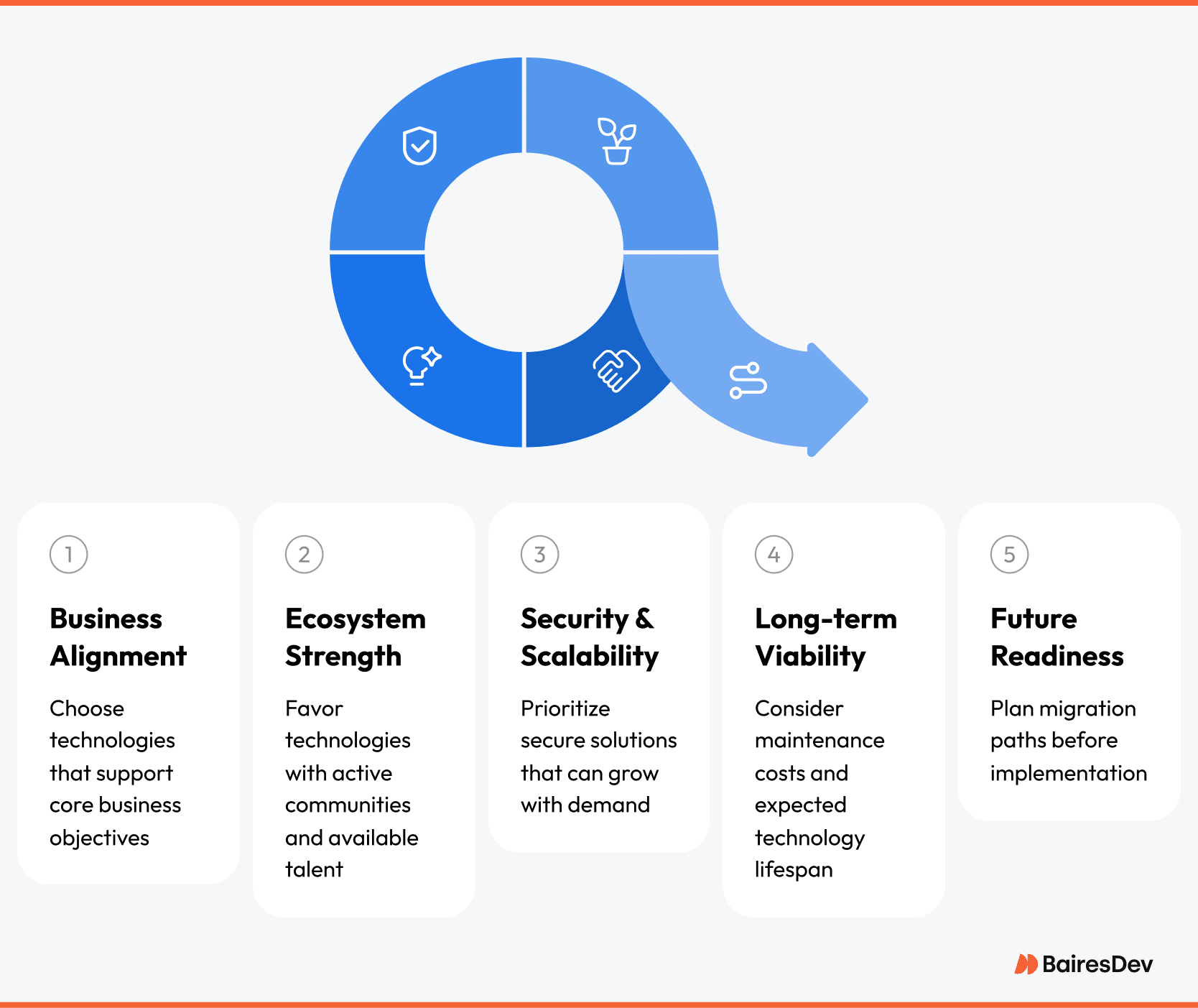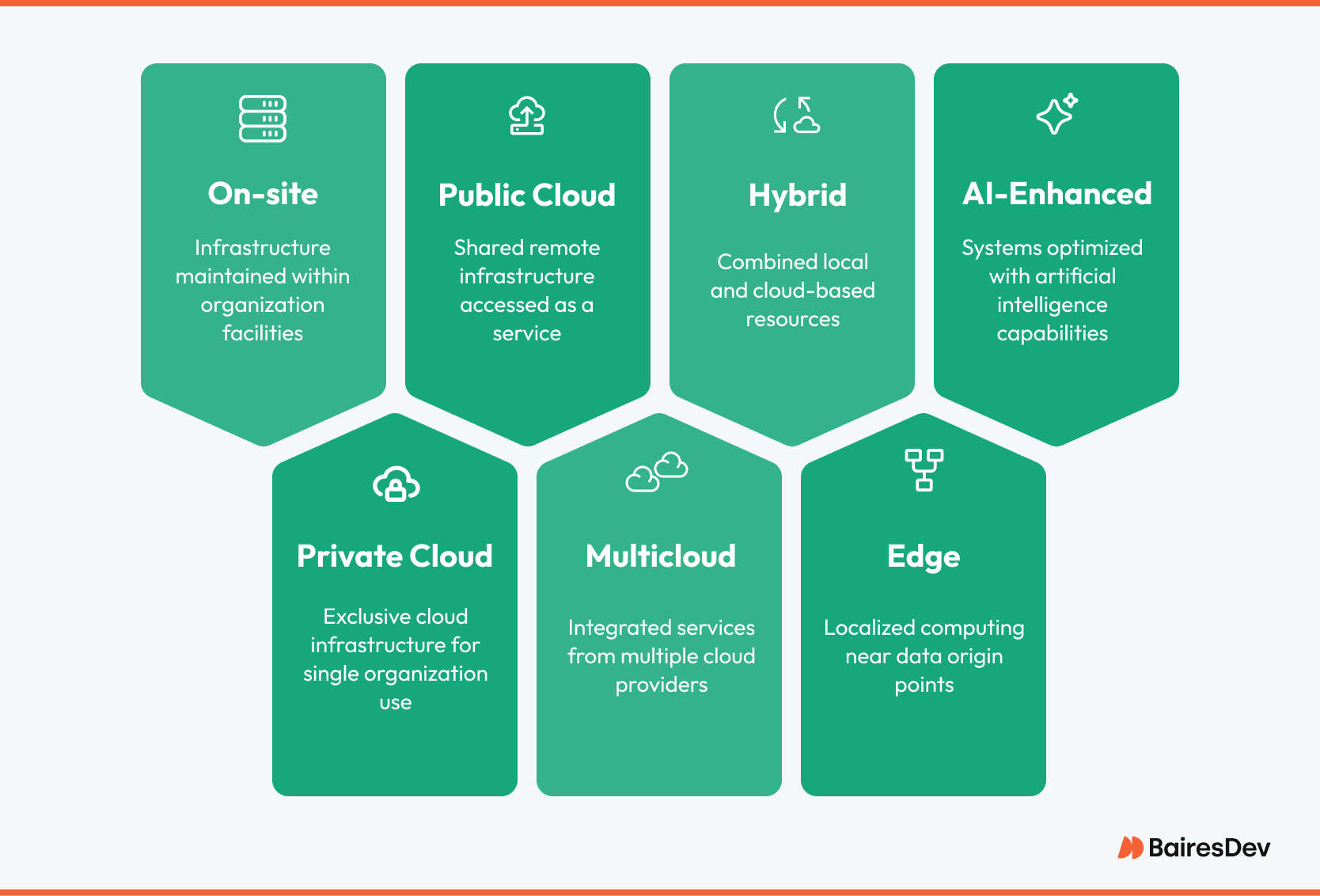Future-proofing your tech stack is not optional. Choosing the right technological foundation allows teams to design software capable of adapting to evolving business needs and ensures long-term viability.
To understand the importance of future-proofing, we need to look at the impact of poor choices and consider the implications. Bad infrastructure decisions often come back to haunt software engineers and are difficult or downright impossible to undo.
The Impact of Poor Tech Stack and Infrastructure Choices
Let’s entertain a hypothetical scenario.
You and a couple of colleagues decide to build a minimum viable product (MVP) and transform your hobby project into a business. Congratulations, it’s a runaway success! You’re signing clients left and right, you leave your day job, start to expand the team and refine the product. But then you hit a wall.
In your pursuit of speed and cost savings, you accumulated a lot of technical debt and as more people sign up, you start to realize that your solution doesn’t scale. Performance issues emerge, and high cloud costs impact your operational efficiency. You try to cut corners, but you skimp on testing.
Then, your users identify a glaring security flaw in your API. You try to address the issue by hiring more experts, only to realize that finding the right talent is extremely difficult. You and your colleagues used legacy technologies you were comfortable with, but the industry moved on. Few people use the needed frameworks and tools, and those willing to take the job are asking for a small fortune to save your project, fix the security flaws and help you migrate.
Granted, this is not a particularly realistic scenario, and the founders made a series of poor decisions. Even experienced engineers can make amateurish mistakes, so don’t blame them too much.
Now let’s dissect this scenario and see what teams should do:
- Align infrastructure needs with business needs
- Prioritize technologies with a thriving developer ecosystem
- Emphasize security and scalability
- Focus on longevity and cost-effective maintenance
- Identify upgrade and migration paths
Choosing the right tech stack takes time and this process should not be rushed. You can build a tent without a good foundation, but not a 5-bedroom house. In our example, you can build an MVP, but not a successful SaaS.
Tech Stack Selection Criteria
The selection criteria vary from project to project, but let’s cover the previously outlined priorities.

Alignment with Business Needs
Tech stack choices should consider immediate needs and be aligned with long-term growth goals and strategic objectives. Startups are all about reducing costs while emphasizing speed and agility. Enterprises focus on robust backends, reliability, compliance, etc. Regardless of size, every organization needs to consider long-term costs, such as maintenance and upgrades. Businesses should explore hidden costs, too. Forced migrations and niche developers can be expensive.
Developer Community and Availability of Talent
Try to prioritize stacks with active developer communities and a large talent pool. A thriving community means you can expect more support and have an easier time sourcing talent. Your team may need to adopt new technologies. Help them upskill. The learning curve for emerging technologies can be steep and your team may need time to adapt. Consult your team from day one. Their feedback may prove invaluable.
Scalable and Secure Solutions
Choosing cloud-native technologies is a good way of ensuring scalability, though cloud technologies may limit your options. Make sure to make sustainable infrastructure choices, as cloud costs can derail your plans. FinOps specialists or consultants may be required to keep costs manageable. Prioritize security from day one, especially if your business model revolves around personal data and involves financial transactions.
Effective Maintenance
Maintenance costs can escalate overnight, rendering operations unsustainable. As a project scales, it has to accommodate more features, integrations, data, etc. As technical debt is accumulated, maintenance overhead becomes a burden. Relying on outdated technologies compounds the problem. Using a regularly updated, modern stack and enforcing best practices helps keep maintenance costs manageable.
Upgrade and Migration Paths
Even if you make all the right choices, you may be forced to migrate or upgrade. Remember our hypothetical scenario? Now, imagine the team did everything right. Their product becomes an overnight sensation, exceeding their wildest expectations. The situation requires them to migrate to a different cloud provider and upgrade their platform. Luckily, this time around, they made all the right choices. They planned ahead. The migration and update go without a hitch, and the product continues to grow and evolve.
Infrastructure Choices

We narrowed down our software stack selection criteria, but what about hardware? IT infrastructure was revolutionized with the advent of virtualization and cloud systems. Virtualization enabled resource abstraction, while cloud computing led to the creation of new services based on flexible and scalable models.
Cloud migration became the norm in the early 2010s, and cloud-native development further accelerated the trend. Engineering teams have started to rely increasingly on Docker and Kubernetes to orchestrate microservices in the cloud. Hybrid and multi-cloud strategies emerged as companies tried to avoid vendor lock-in and ensure data sovereignty. So what comes next?
Artificial Intelligence and Machine Learning
As AI became more advanced and accessible, companies started integrating AI and ML into their products. Cloud computing providers embraced artificial intelligence to further optimize their services and unlock a range of benefits:
- Smarter automation: AI allows providers to automate resource scaling, manage administrative tasks, improve help desk operations, and automate many aspects of cloud management and implementation.
- Lower costs: AI’s ability to handle increasingly complex tasks and streamline operations saves time and money.
- Improved security: By monitoring networks and user behavior for certain patterns, AI helps detect threats and identify vulnerabilities.
- Enhanced data analytics: AI’s data processing abilities are also used for predictive analytics. Traditional data management is improved, too.
These benefits allow cloud providers to streamline operations and generate higher margins, while at the same time improving customer satisfaction.
The Increasing Popularity of Hybrid and Multicloud Strategies
Interest in hybrid and multicloud solutions continues to grow. Companies typically adopt hybrid cloud strategies to ensure data sovereignty, improve reliability, security, disaster recovery, and latencies. The use of private cloud solutions in regulated industries is fairly common, and hybrid cloud provides companies with the ability to extend functionality while managing public and private clouds as a single entity.
Multicloud strategies allow companies to prevent vendor lock-in and secure more competitive pricing. By using multiple cloud providers, organizations can reap the benefits offered by different cloud vendors. For example, one provider may offer more competitive data storage rates while a competitor provides superior latency in a specific region. Why not use both?
Multiples suggest that the majority of organizations are already using a multicloud approach, and Gartner expects up to 90% of organizations will embrace hybrid cloud systems by 2027.
The Rise of Edge Computing
Speaking of latencies, edge computing addresses the increasing need for real-time data processing. While traditional cloud services offer unparalleled efficiency for most applications, the rise of edge devices has created a challenge: How do we ensure efficient, low-latency processing for billions of new devices in diverse locations?
Edge computing places computation and storage as close to the data source as possible. This minimizes the need to transfer data to big cloud platforms, helping reduce latencies, bandwidth consumption, and unnecessary processing. Internet of Things (IoT) devices tend to collect a lot of data that ends up unused, so there’s no need to move and process all of it. There is another reason to keep IoT devices dissociated from other parts of the network: security. Inexpensive consumer-grade IoT devices are not known for top-notch security, so many security experts prefer to keep them at arm’s length.
Investment in edge computing is accelerating. According to research firm IDC, the market for edge computing services grew 14% in 2024, reaching $228 billion. By 2028, spending is expected to reach $378 billion.
Cloud Services Market Trends in 2025
What comes next?
According to a recent forecast by Gartner, spending on cloud services in 2025 remains strong and growth is on track to outpace 2024. The forecast examines Cloud Application Infrastructure Services, Cloud Application Services, Cloud Desktop-as-a-Service, and Cloud System Infrastructure Services.
IaaS leads the way and is expected to experience 24.8% growth in 2025, followed by PaaS with 21.6% growth, SaaS at 19.2%, and DaaS at 11.1%. Growth across all four categories is accelerating.
Gartner found that the use of AI is accelerating demand for cloud services and that the focus on hybrid and multicloud environments is increasing.
Strong Demand for FinOps, AIOps, and DevSecOps Talent
As spending on cloud services continues to grow, so does demand for specialized talent. In addition to securing software engineers, businesses must consider whether they will need more cloud specialists, AI engineers, and security experts.
FinOps Professionals
FinOps (Financial Operations) professionals focus on optimizing cloud spending. Considering the increase in cloud spending, it’s no wonder that demand for FinOps services remains high. The FinOps Foundation estimates that more than 40% of organizations need more FinOps talent, and that demand for FinOps professionals will continue to outpace supply.
Securing AIOps Talent
AIOps (AI Operations) is the practice of using machine learning and artificial intelligence to improve IT operations. Demand for AIOps talent is expected to stay strong for the foreseeable future, and supply will likely remain constrained. With AI operations being embraced left and right, businesses might have a hard time accessing enough talent capable of automating their IT operations.
Popularization of DevSecOps
DevSecOps integrates security into DevOps pipelines, effectively complementing DevOps. DevSecOps is supposed to make deployment workflows more efficient by automating security checks in Continuous Integration/Continuous Development (CI/CD) pipelines.
Future-Proofing Through Technology and Talent
Building a resilient foundation for future projects is non-negotiable. But tools alone won’t suffice.
As technology continues to evolve, so will people and organizations. Exceptional talent and organizational excellence, coupled with the right strategies and a culture that encourages innovation, will lay the foundation for long-term success.
As more companies adopt AI-driven technologies, the need for specialized talent will be greater than ever. Project outcomes will depend on an organization’s ability to choose the right software and hardware for the job and the human capability to successfully use the tools at their disposal.







